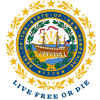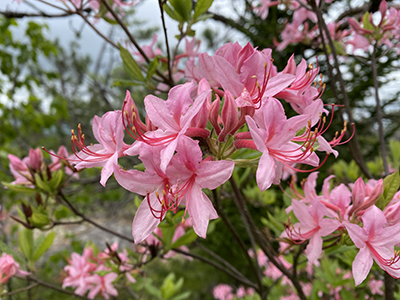Rare Native Plants
Information about the native plants in New Hampshire that are considered rare and how they are ranked.
What Species Are Protected In New Hampshire?
NH Natural Heritage Bureau (NHB) primarily assists with the protection of native plants within the state that are endangered or threatened. If necessary, NHB may also protect non-rare native plants to maintain and enhance population numbers. Plants that are protected but not rare include those that are at risk due to loss, modification, or severe destruction of their habitats, or because of exploitation for commercial, scientific, educational, or private use. NHB maintains records on approximately 400 plant species judged to be endangered or threatened under the Native Plant Protection Act 1987 (RSA 217-A)
Range-wide distribution maps, state and provincial ranks, and other information on the status of all plants and animals in North America can be found at the NatureServe website.
What Is The Native Plant Protection Act?
In 1987, the New Hampshire state legislature passed the Native Plant Protection Act (RSA 217-A) and formally recognized that "for human needs and enjoyment, the interests of science, and the economy of the state, native plants throughout this state should be protected and conserved; and…their numbers should be maintained and enhanced to insure their perpetuation as viable components of their ecosystems for the benefit of the people of New Hampshire." To compile a list of the species requiring protection, the NH Natural Heritage Bureau collaborates with knowledgeable botanists and identifies the most imperiled taxa as "endangered" and those likely to become endangered as "threatened."
How Does NHB Protect Federally Listed Species?
Three of New Hampshire’s rare plants are not only state-listed under the Endangered Species Act, but federally-listed as well. Jesup's milk-vetch (Astragalus robbinsii var. jesupii) and northeastern bulrush (Scirpus ancistrochaetus) are federally endangered while small whorled pogonia (Isotria medeoloides) is federally threatened. NHB facilitates the recovery of these federally-listed plant species by developing restoration and recovery objectives, implementing conservation measures, and monitoring populations. NHBs recovery efforts for these species in 2021 and 2022 are summarized below.
Small Whorled Pogonia Recovery Efforts:
- Light Detection and Ranging (LIDAR) imagery and habitat predictive models were used to aid in finding potential habitat for small whorled pogonia. De novo searches were conducted to find new populations in these areas identified as potential suitable habitat.
- 113 sites were surveyed for known and previously unknown populations resulting in 1,773 stems being found as well as several new subpopulations. Monitoring of these sites contributes to the NHB database and other datasets including specific populations that have been manipulated and monitored since 1997 to observe the effects of habitat management on the plants.
- Leaves were collected from 110 plants to aid dogs in scent training so that they can help with survey efforts in the future for previously unknown populations or hard to find plants. These leaves were then sent to the Smithsonian Environmental Research Center and Longwood Gardens to aid in research and increasing the knowledgebase on this species.
Jesup's Milk Vetch Recovery Efforts:
- The only known naturally occurring populations of Jesup’s milk vetch globally are at 3 sites in New Hampshire and Vermont. Three known populations were monitored resulting in a total count of 2,318 plants which is a significant increase from the 438 plants counted the previous year in these locations. One introduced population was also monitored and was determined to be persistent.
- Seeds previously collected from a natural population were planted and grown to seedlings at the Native Plant Trust. These seedlings were then planted at several locations where the success of the population is monitored. The percent survival for all transplanted seeds ranged from 1.7% to 22.5% among 4 sites.
- Two existing populations were augmented by planting seedlings, scarified seeds, and seeds collected from seed-bearing natural plants on site. These sites experienced survival rates of 11% and 33% which is a great improvement compared to the 0% survival at both sites the previous year.
Northeastern Bulrush Recovery Efforts:
- De novo searches conducted in 2014 discovered a significant population in southern NH. In 2021, NHB staff accompanied US Fish and Wildlife Service (USFWS) staff to visit this population while also surveying a nearby basin swamp that had not previously been surveyed. The rare plant was not found here, nor was it found in wetlands on another property in southern NH nearby a single clump of northeastern bulrush originally found in 2014.
- In 2019 USFWS initiated a 5-year review in which they propose to delist northeastern bulrush because they consider it to be in recovery. At the time of the 2009 review New Hampshire had nine known populations, and as of 2019 there were 14 known populations. Future actions are to develop a post-delisting monitoring plan which includes a standardized survey protocol.
How are Rare Species Ranked?
Rank codes describe the degree of risk of a species to extinction throughout its range or extirpation within a state. Extinction risk indicates the likelihood that a species will be lost globally. Extirpation risk indicates the likelihood that a species will be lost at the state level but still exist elsewhere globally.
The tracking list was originally developed in cooperation with professional and amateur botanists, conservation organizations, and other knowledgeable individuals. Plants tracked by NHB are those with state ranks of endangered or threatened.
State Endangered (SE; S1): A native plant taxon at very high risk of extirpation in the state due to very restricted range, very few populations (often though not always five or fewer observed within the last 20 years), very steep declines, severe threats, or other factors. A historical rare native plant taxon is one that has not been observed in the state in over 20 years. It is considered endangered unless there is credible evidence that all previously known populations of the taxon in the state have been extirpated.
Visit the NatureServe website to learn more about global and state rankings.
State Threatened (ST; S2): A native plant taxon at high risk of extirpation in the state due to restricted range, few populations (often though not always between six to twenty observed within the last 20 years), steep declines, severe threats, or other factors.
Visit the NatureServe website to learn more about global and state rankings.
State Watch (SW; S3): A native plant taxon at moderate risk of extirpation in the state due to a fairly restricted range, relatively few populations (often though not always between twenty-one to eighty observed within the last 20 years), recent and widespread declines, threats, or other factors.
Indeterminate (Ind): A plant taxon under review for listing as endangered, threatened, or watch in the state, but its rarity, nativity, taxonomy, and/or nomenclature are not clearly understood.
Visit the NatureServe website to learn more about global and state rankings.





